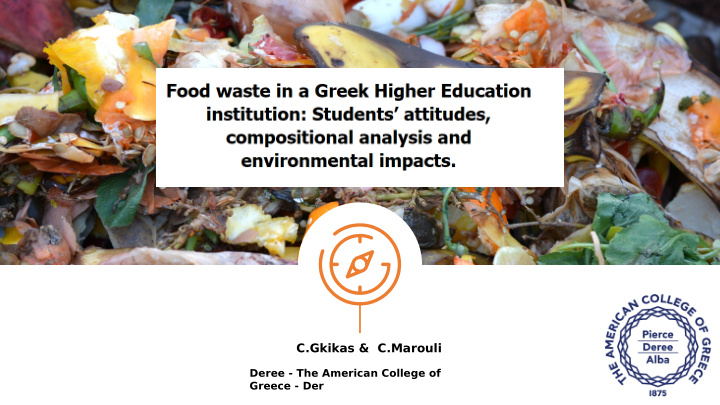



C.Gkikas & C.Marouli Deree - The American College of Greece - Der
Food waste is a signifjcant problem of contemporary societies globally, with noteworthy environmental, social and ethical implications. • 8 % of annual greenhouse gasses (GHG) emissions. • immense malnutrition, resource and land related confmicts. • $930 billion in economic losses.
This study documents the composition of the food waste generated in the main dining facility on campus, as well as the attitudes of students of a Greek higher education institution towards food waste. Furthermore, it attempts to show the way for a more focused estimation of the environmental impacts of food waste with the use of Life Cycle Assessment results. .
Methods As values and attitudes correlate with wastage, in this study we aim to document both the amounts of the food waste generated at the main dining facility of Deree –American College of Greece –, and student attitudes related with food waste generation. 1 2 Weight Survey - measurement Kg Questionnaire: campaign: April 2018 – May March 2018 – April 2018 2018 3 4 Qualitative Compositional Analysis: Data Analysis March 2018 – April 2019
Weight Measurement Campaign Results As the food waste measurement campaign demonstrated most of the food waste is avoidable; 65.35 kg were avoidable, and 34.17 kg were unavoidable. Thus, given the cycle of operation of this college dining facility, it was estimated that 2,777 kg of avoidable and 1,452kg of unavoidable food waste are generated per year. It was estimated that 2,777 kg of avoidable and 1,452kg of 80% of Avoidable 95% of Unavoidable unavoidable food waste are generated per This is a sample text. year.* Enter your text here.
1.1. Survey results • In terms of students’ perceptions about food consumption, survey results demonstrated that respondents’ satisfaction does not relate with the variety of plates (64.5%) they purchase, while there was no clear agreement that the variety of plates is a sign of social status (49% neither agree or disagree, 32.5% disagree and 22.5% agree). This is a sample text. Enter your text here.
1.2. Survey results • The main reasons that respondents do not complete their meal are: because they are full (70%); because they don’t like the food (30%); and only 5% as an issue of prestige. Only 2.5% of the respondents always complete their meal. This is a sample text. Enter your text here.
1.3. Survey results Other fjndings regarding consumers’ perceptions of the environmental impacts or the social and economic valuation of food waste revealed that: • Most of the respondents were aware of the negative environmental impacts of food waste. 50% of the respondents considered food waste an important environmental problem (very or extremely environmentally harmful), while 7.5% thought that it had no negative environmental impacts. • Respondents generally felt some guilt relating with food waste, indicating some sense of responsibility for the possible harm done. The overwhelming majority felt guilty towards needy people when wasting food (95%); only 5% did not. Regarding their guilt feelings towards the environment, their responses are mixed: 40% agreed or This is a sample text. strongly agreed and 27.5% disagreed or strongly disagreed. Most of Enter your text here. the respondents felt guilt regarding the subsequent waste of money
This is a sample text. Enter your text here.
Main fjndings • Students dining in the facility do not associate satisfaction with the variety and the abundance of food choices or plates. • It is unclear whether there is a correlation of conspicuous consumption and identity-signaling; results do not clearly support the idea that food selection correlates with a desire to demonstrate social status or internal sense of worth.
• Students believe that they have adequate general knowledge of the environmental impacts of food waste (but this should be further investigated). • Students' feelings of responsibility for these impacts are weak. It is interesting to note that they do express some sense of guilt relating with hungry people when they waste food, and they identify money/cost as a main source of infmuence for their sense of responsibility related with food waste. These fjndings highlight the complexity of the motivators for change in environmental behaviors; knowledge by itself is not suffjcient, diverse feelings may be involved, while monetary parameters are signifjcant.
Direct Impacts : impacts produced by 1 1 the food waste material itself GHG Wildlife Emissions, Indirect Impacts : Efgects: Water those related with the Hybridization Pollution, Soil production, of domestic Erosion etc. 2 2 processing, and wild distribution (i.e. the species, life cycle) of the food Decrease in that ends up as food genetical waste diversity etc. Societal Efgects: Spread of Zoonotic Diseases
In an attempt to identify an efgective method for the estimation of environmental impacts from food wastage, results of Life Cycle Assessment studies were used for the main two components identifjed in the food waste: French fries and orange peels. The estimation of the impacts of orange peels could not be efgectively concluded as the retrieved LCA results referred to the whole orange juice production process in an industrial setting. Based on the results of the French fries LCA conducted by Mouron, Willersinn, Möbius, & Lansche (2016), it was estimated that from the disposed French fries alone on an annual basis the Deree dining facility produces 4,551 kg of CO2 equivalents (global warming potential), 91,375 MJ equivalents (demand for nonrenewable energy resources), 1,576.2 kg 1.4-DB equivalents (human toxicity), 8.88 kg 1.4-DB equivalents (terrestrial ecotoxicity), and 888 kg 1.4-DB equivalents (aquatic ecotoxicity) .
Final remarks • A useful approach to the analysis of the drivers of food waste generation at the consumers’ level : identifying three relevant stages in the process (food acquisition, food consumption, post-food consumption). • Use of LCA results for a more accurate discussion of food waste environmental impacts
Thank you
Recommend
More recommend